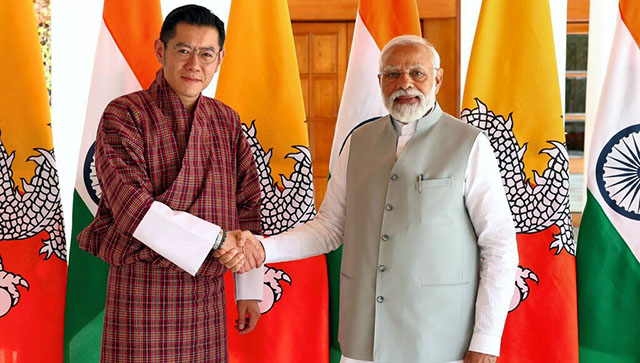Pakistan and China have been particularly cautious and envious of the cordiality that characterises the relationship between Bhutan and India. Indeed, if we were to symbolically epitomise it, the Indian embassy in Thimphu is not only majestic but also the largest in the world. The grandeur with which it has been placed and decorated, both in its exterior and its opulent interiors, showcases the heartbeat with which each nation approaches the well-being of the other. During a visit to the Himalayan kingdom in 2013, the author experienced courtesy from the glitterati, cognoscenti and paparazzi of Bhutan. He met His Majesty King-4, the then Prime Minister of Bhutan, the Cabinet Secretary, and the Chief Operations Officer, equivalent to the Indian Army chief. Kuensel carried a full-page interview of the author. Reflecting on the experience, the author wondered whether the relationship remained as genial a decade later. There has been a Three-Step Agreement signed by Bhutan with China and it appears that the “Northern dragon” is attempting to woo Druk Yul, as Bhutan is known. Protracted discussions with His Majesty King-4, the prime minister, the Cabinet Secretary, and the Chief Operations Officer in 2013 revealed to the author that the Himalayan Kingdom’s heart concerning India remains in the right place. Therefore, even if the sovereign nation of Bhutan, which India respects and adores, were to enter into a dialogue with China, it is almost certain that it would have done so after considering its age-old kinship with India and consulting New Delhi before entering into a Three-Step Agreement. The recent visit by His Majesty King-5 to India (and Assam), where he met Indian Prime Minister Narendra Modi, speaks volumes about the bonhomie that characterized the two neighbours. The decision by Bhutan and India to focus on connectivity and infrastructure is a crucial step towards more bilaterally driven regional initiatives. A joint statement hailed the completion of the joint surveys for the Gelephu-Kokrajhar railway link that connects Assam with Bhutan, as well as the beginning of discussions on another railway link with West Bengal, marking important bilateral milestones. These plans foreshadow a future that could well change the development story of the region, including West Bengal and the Northeast, Bhutan’s south and east districts, as well as Northern Bangladesh. Bhutan’s economy has been dependent on hydropower and tourism revenues and suffered as a result of COVID-19. A Special Economic Zone at Bhutan’s southern border with Assam and an airport at Gelephu are expected to drive growth and investment in the kingdom. In addition, Bangladesh’s signing of a Preferential Trade Agreement with Bhutan in 2020 could increase Bhutanese exports of local produce and create more markets for Indian and Bangladeshi producers in the sub-region. India’s ’energy exchange,’ which is bringing more Bhutanese and Nepali hydropower suppliers online, while planning to distribute energy to Bangladesh and Sri Lanka, will drive intra-regional growth and revenues. This would also power New Delhi’s attempt at bridging the economic gap with the Northeast, even as it draws development partners like the World Bank and donor countries like Japan into the creation of a ‘sub-regional hub.’ Time-bound implementation continues to be the key to these ambitious bilateral plans. This is particularly important as there are hints of dissonance with China, Pakistan, as well as with Myanmar, the latter of which came by way of the 1 February 2021 coup. It is important for India to pave a seamless path for trade and land connectivity to the East. This has to be forged by working with other countries on India’s periphery to build connectivity, markets, and energy links. Indeed, it is the only sustainable way forward. In the longer term, geopolitical conflicts and anti-globalisation trends are forcing regional groupings to become cohesive, something South Asia has not been able to come to terms with yet. As India worries about China’s inroads into South Asian trade, infrastructure projects, and strategic ties, its concerns over a Sino-Bhutan boundary agreement arise. However, it must be said that the all-weather relationship enjoyed by Bhutan and India will never permit India’s strategic concerns over Doklam or India’s “Chicken Neck” (Siliguri Corridor). The conjoining of strategic imperatives has always been the hallmark of India-Bhutan security. The dualities that accompany such ideation and extra-regional threats will offset the “fire and brimstone” that seeks to spew over countries involved, particularly those that continue to have live pachyderms as opposed to mythical and “long-extinct” dragons of yore. The writer is a conflict theorist and bestselling author. Views expressed in the above piece are personal and solely that of the author. They do not necessarily reflect Firstpost’s views. Read all the Latest News , Trending News , Cricket News , Bollywood News , India News and Entertainment News here. Follow us on Facebook , Twitter and Instagram .
How India-Bhutan ties remain a pillar of stability despite regional challenges
Jaideep Saikia
• December 10, 2023, 11:52:06 IST
The conjoining of strategic imperatives has always been the hallmark of India-Bhutan security
Advertisement
)
End of Article